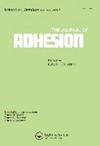Research on the Aging Effects of Adhesive and Composites on the Degradation Mechanism of Composite Adhesive Joints in Thermal-Humidity-Cycles for Automobiles
IF 2.3
4区 材料科学
Q2 ENGINEERING, CHEMICAL
引用次数: 0
Abstract
ABSTRACT The existing studies on the degradation mechanism of composite adhesive joints mostly focus on the aging of adhesives, but the aging effect of composites is often ignored. In this paper, the degradation mechanism of adhesive, CFRP, as well as shear joints (SJ) and butt joints (BJ) in thermal-humidity-cycles (T-H-C) for automobiles were investigated by chemical detection and mechanical testing. The aging effects of adhesives and composites are compared and analyzed by the variation in chemical and mechanical properties to reveal the degradation mechanism of composite adhesive joints. Experimental testing show that the adhesive and CFRP underwent hydrolysis and oxidative decomposition respectively, and there was a reduction in Tg (glass transition temperature) and thermal stability. The joint strength of composite adhesive joints fell by around 40% after 30d (days), and interfacial failure appeared. The variation in the composition of adhesive and CFRP, interfacial failure and thermal stress contributed to the degradation of composite adhesive joints. Degradation mechanism analysis shows that SJ under shear stress state were less affected by CFRP aging, while BJ under normal stress state were more affected by CFRP aging and the effect became more obvious with time growth.胶粘剂和复合材料老化对汽车湿热循环中复合胶粘剂接头降解机理的影响研究
现有的复合材料胶粘剂接头降解机理研究多集中在胶粘剂的老化上,而往往忽略了复合材料的老化效应。通过化学检测和力学试验,研究了汽车用胶粘剂、碳纤维增强塑料(CFRP)以及汽车用剪切接头(SJ)和对接接头(BJ)在热湿循环(T-H-C)中的降解机理。通过化学性能和力学性能的变化对比分析了胶粘剂和复合材料的老化效应,揭示了复合胶粘剂接头的降解机理。实验测试表明,胶粘剂和CFRP分别发生水解和氧化分解,玻璃化转变温度Tg和热稳定性降低。复合胶合接头在30d (d)后接头强度下降40%左右,出现界面破坏。胶粘剂与碳纤维布组成的变化、界面破坏和热应力是复合胶粘剂接头退化的主要原因。降解机理分析表明,剪切应力状态下的SJ受CFRP老化的影响较小,而正应力状态下的BJ受CFRP老化的影响较大,且随着时间的增长,影响更加明显。
本文章由计算机程序翻译,如有差异,请以英文原文为准。
求助全文
约1分钟内获得全文
求助全文
来源期刊

Journal of Adhesion
工程技术-材料科学:综合
CiteScore
5.30
自引率
9.10%
发文量
55
审稿时长
1 months
期刊介绍:
The Journal of Adhesion is dedicated to perpetuating understanding of the phenomenon of adhesion and its practical applications. The art of adhesion is maturing into a science that requires a broad, coordinated interdisciplinary effort to help illuminate its complex nature and numerous manifestations.
 求助内容:
求助内容: 应助结果提醒方式:
应助结果提醒方式:


